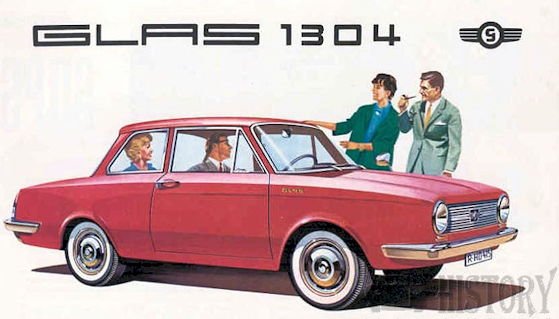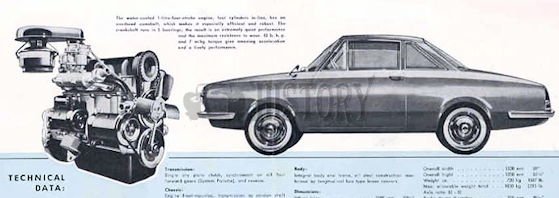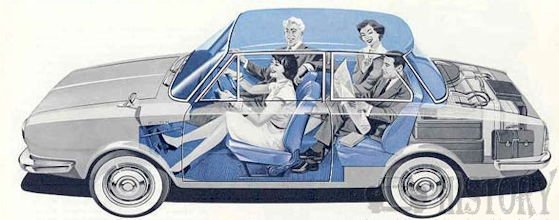Glas 1304
 |
|
| Manufacturer | Hans Glas GmbH |
|---|---|
| Production | 1965 to 1968 |
| Class | Motor car |
| Produced | 40,703 units total |
| Assembly | Dingolfing |
| Body style | coupé, saloon, cabriolet,estate |
| Layout | FR layout |
| Engine | 4-cylinder in-line 1304: 1290 cc |
| Transmission | 4-speed manual all-synchromesh |
| Wheelbase | 2,100 mm (83 in) |
| Length | 3,835 mm (151.0 in) |
| Width | 1,500 mm (59 in) |
| Height | saloon & estate: 1,370 mm (54 in) |
History
But the medium-sized European car cannot be something designed solely for the town nor solely for long journeys. And so the Glas is also a car with, an adequate performance out on the road. It has an engine that allows speeds of 93 mph (150 km/h) to kept up with no trouble on motorways and will face the most tortuous roads eagerly with a quick and lively gearbox and the possibility of doing over 72 mph (116 km/h) in third. Lively acceleration is guaranteed by an engine with a high compression ratio. A ' favourable power-weight ratio makes this performance particularly brilliant. But at this point, another of the essential requirements of the family car must be considered fuel consumption. The Glas will do about 35 miles to imperial gallon (29 US) and uses 8 litres per hundred kilometres, and is thus is a more than respectable performer in this sense.

Given the simplicity of the mechanical elements, servicing and maintenance too ,are extremely economical. In cars destined for a wide market, the problem the designer must
find a solution for is always how to find the right compromise between many demands. It must be roomy enough for four, reliable because it will be used on the job, speedy because there will be long motorway journeys to do, economical because it must suit every pocket. The result seems to be particularly praiseworthy in the Glas because the compromise has been achieved without sacrificing any of the elements.
1304 TS
In September 1965 the 1,290 cc engine from the Glas GT was installed, giving rise to a new top of the range model which now offered maximum power of 62.5 kW (85 PS) and a top speed of 168 km/h (104 mph).
PERFORMANCE
Engine capacity: 78.72 cu in, 1,290 cu cm
Fuel consumption: 35.3 m/imp gal, 29.4 m/US gal, 8 1 x 100 km
Max speed: 105.6 mph, 170 km/h
max power(DIN): 85 hp at 5,800 rpm
max torque (DIN): 80 1b ft, 11 kg m at 3,000 rpm
max engine rpm: 6,300
specific power: 65.9 hp/l
power-weight ratio: 19.2 lb/hp, 8.7 kg/hp

1304/S 1304
A single carburetter version of the 1304 engine also became available in 1965, which still offered 44 kW (60 PS) of power and commensurate performance.
1304 CL
Two fastback bodied kombi-limousines (estate cars) arrived in August 1966. Estate cars of this size – at least in Germany – were still relatively uncommon. The kombi-limousines could be purchased as either 1004 CL or 1304 CL, with the "CL" standing for Combi Limousine. The Glas estate cars met with little success in the market place. Despite the rear tailgate, luggage space and rear leg room was severely limited thanks to the car’s short wheelbase. With a single carburetter the 1304 has 60 PS (44 kW) at 5000 rpm; this was enough for a claimed 148 km/h (92 mph) top speed. The CL continued to be available for a little while after the BMW takeover (until April 1968). It also inspired BMW's then Sales Director Hahnemann to develop the '02-series Touring.

Technical
-
Glas 1304 Technical details and specifications (1965-1968)
ENGINE
location front
4 stroke; cylinders: 4, in line
bore and stroke: 2.95 x 2.87 in, 75 x 73mm
engine capacity: 78.72 cu in, 1,290 cu cm
compression ratio: 9.2 or 9.3
cylinder block: cast iron
cylinder head:light alloy
crankshaft bearings: 5
valves: 2 per cylinder, overhead, Vee-slanted at 30°, rockers
camshafts: 1, overhead, cogged belt
lubrication: gear pump, full flow filter
carburation:2 Solex 35 RH horizontal carburettors
fuel feed: 2 mechanical pumps
cooling system: water
TRANSMISSION
driving wheels: rear
clutch: single dry plate, hydraulically controlled
gearbox: mechanical; gears: 4 + reverse
synchromesh gears: II,III, IV
gearbox ratios: I 3.820, II 2.070, III 1.330, IV 1, rev 4.150
gear lever: central
final drive: hypoid bevel
axle ratio: 3.889CHASSIS
integral
front suspension: independent, upper leading arms, lower transverse arms, rubber springs (compression), coil springs, anti-roll bar, telescopic dampers
rear suspension: rigid axle, semi-elliptic leafsprings, rubber springs (compression), telescopic dampers.STEERING
worm and roller
turns of steering wheel lock to lock: 2.50.
turning circle (between walls): 31.2 ft, 9.5 mBRAKES
front disc (diameter 9.45 in, 240 mm), rear drum.ELECTRICAL EQUIPMENT
voltage: 6 V
battery: 77 Ah
generator type: dynamo, 200 W
ignition distributor: BoschDIMENSIONS AND WEIGHT
wheel base: 82.68 in, 2,100 mm
front track: 48.43 in, 1,230 mm
rear track: 47.24 in, 1,200 mm
overall length: 150.98 in, 3,835 mm
overall width: 59.05 in, 1,500 mm
overall height: 53.15 in, 1,350 mm
ground clearance: 7.48 in, 190 mm
dry weight: 1,632 1b, 740 kg
distribution of weight: 60.5% front axle, 39.5% rear axle© Motor car History
Service
-
Glas 1304 Maintenance and Service Guide (1965-1968)
Fuel: 98-100 oct petrol
Engine sump oil: 4.40 imp pt, 5.28 US pt, 2.5 1, SAE 10W-30 HD, change every 3,700 miles, 6,000 km
Total lubricating system capacity: 5.10 imp pt, 6.13 US pt, 2.9 1
Gear-box oil: 2.11 imp pt, 2.54 US pt, 1.21, SAE 80, change every 14,900 miles, 24,000 km
Final drive oil: 1.41 imp pt, 1.69 US pt, 0.81, SAE 90, change every 14,900 miles, 24,000km
Cooling system capacity: 14.96 imp pt, 17.97 US pt
Greasing: every 1,900 miles, 3,000 km, 7 points
Width of rims: 4.5"
Tyres: 155 x 13
Fuel tank capacity: 8.80 imp gal, 10.56 US gal
Carrying capacity: 706 1b, 320 kg.© Motor car History
